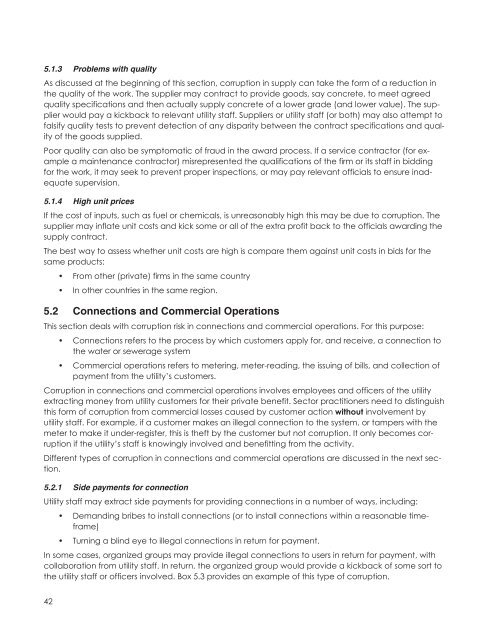A Sourcebook - UN-Water
A Sourcebook - UN-Water
A Sourcebook - UN-Water
You also want an ePaper? Increase the reach of your titles
YUMPU automatically turns print PDFs into web optimized ePapers that Google loves.
5.1.3 Problems with quality<br />
As discussed at the beginning of this section, corruption in supply can take the form of a reduction in<br />
the quality of the work. The supplier may contract to provide goods, say concrete, to meet agreed<br />
quality specifications and then actually supply concrete of a lower grade (and lower value). The supplier<br />
would pay a kickback to relevant utility staff. Suppliers or utility staff (or both) may also attempt to<br />
falsify quality tests to prevent detection of any disparity between the contract specifications and quality<br />
of the goods supplied.<br />
Poor quality can also be symptomatic of fraud in the award process. If a service contractor (for example<br />
a maintenance contractor) misrepresented the qualifications of the firm or its staff in bidding<br />
for the work, it may seek to prevent proper inspections, or may pay relevant officials to ensure inadequate<br />
supervision.<br />
5.1.4 High unit prices<br />
If the cost of inputs, such as fuel or chemicals, is unreasonably high this may be due to corruption. The<br />
supplier may inflate unit costs and kick some or all of the extra profit back to the officials awarding the<br />
supply contract.<br />
The best way to assess whether unit costs are high is compare them against unit costs in bids for the<br />
same products:<br />
• From other (private) firms in the same country<br />
• In other countries in the same region.<br />
5.2 Connections and Commercial Operations<br />
This section deals with corruption risk in connections and commercial operations. For this purpose:<br />
• Connections refers to the process by which customers apply for, and receive, a connection to<br />
the water or sewerage system<br />
• Commercial operations refers to metering, meter-reading, the issuing of bills, and collection of<br />
payment from the utility’s customers.<br />
Corruption in connections and commercial operations involves employees and officers of the utility<br />
extracting money from utility customers for their private benefit. Sector practitioners need to distinguish<br />
this form of corruption from commercial losses caused by customer action without involvement by<br />
utility staff. For example, if a customer makes an illegal connection to the system, or tampers with the<br />
meter to make it under-register, this is theft by the customer but not corruption. It only becomes corruption<br />
if the utility’s staff is knowingly involved and benefitting from the activity.<br />
Different types of corruption in connections and commercial operations are discussed in the next section.<br />
5.2.1 Side payments for connection<br />
Utility staff may extract side payments for providing connections in a number of ways, including:<br />
• Demanding bribes to install connections (or to install connections within a reasonable timeframe)<br />
• Turning a blind eye to illegal connections in return for payment.<br />
In some cases, organized groups may provide illegal connections to users in return for payment, with<br />
collaboration from utility staff. In return, the organized group would provide a kickback of some sort to<br />
the utility staff or officers involved. Box 5.3 provides an example of this type of corruption.<br />
42
















